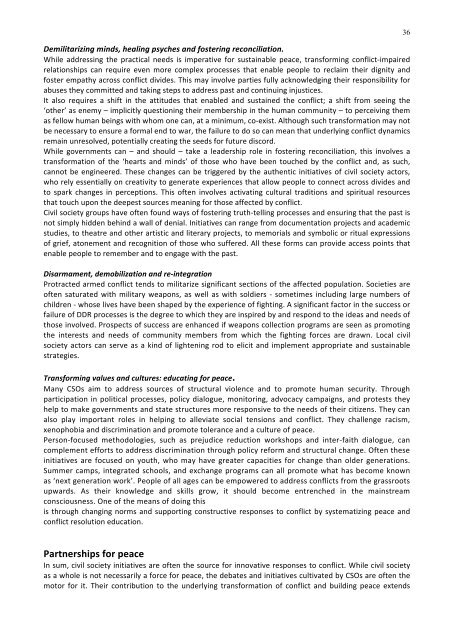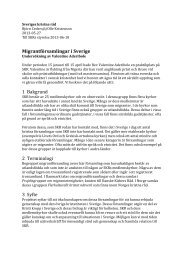Tyngdpunktsförskjutning rapport (PDF) - Sveriges kristna råd
Tyngdpunktsförskjutning rapport (PDF) - Sveriges kristna råd
Tyngdpunktsförskjutning rapport (PDF) - Sveriges kristna råd
You also want an ePaper? Increase the reach of your titles
YUMPU automatically turns print PDFs into web optimized ePapers that Google loves.
Demilitarizing minds, healing psyches and fostering reconciliation.<br />
While addressing the practical needs is imperative for sustainable peace, transforming conflict-‐impaired<br />
relationships can require even more complex processes that enable people to reclaim their dignity and<br />
foster empathy across conflict divides. This may involve parties fully acknowledging their responsibility for<br />
abuses they committed and taking steps to address past and continuing injustices.<br />
It also requires a shift in the attitudes that enabled and sustained the conflict; a shift from seeing the<br />
‘other’ as enemy – implicitly questioning their membership in the human community – to perceiving them<br />
as fellow human beings with whom one can, at a minimum, co-‐exist. Although such transformation may not<br />
be necessary to ensure a formal end to war, the failure to do so can mean that underlying conflict dynamics<br />
remain unresolved, potentially creating the seeds for future discord.<br />
While governments can – and should – take a leadership role in fostering reconciliation, this involves a<br />
transformation of the ‘hearts and minds’ of those who have been touched by the conflict and, as such,<br />
cannot be engineered. These changes can be triggered by the authentic initiatives of civil society actors,<br />
who rely essentially on creativity to generate experiences that allow people to connect across divides and<br />
to spark changes in perceptions. This often involves activating cultural traditions and spiritual resources<br />
that touch upon the deepest sources meaning for those affected by conflict.<br />
Civil society groups have often found ways of fostering truth-‐telling processes and ensuring that the past is<br />
not simply hidden behind a wall of denial. Initiatives can range from documentation projects and academic<br />
studies, to theatre and other artistic and literary projects, to memorials and symbolic or ritual expressions<br />
of grief, atonement and recognition of those who suffered. All these forms can provide access points that<br />
enable people to remember and to engage with the past.<br />
Disarmament, demobilization and re-‐integration<br />
Protracted armed conflict tends to militarize significant sections of the affected population. Societies are<br />
often saturated with military weapons, as well as with soldiers -‐ sometimes including large numbers of<br />
children -‐ whose lives have been shaped by the experience of fighting. A significant factor in the success or<br />
failure of DDR processes is the degree to which they are inspired by and respond to the ideas and needs of<br />
those involved. Prospects of success are enhanced if weapons collection programs are seen as promoting<br />
the interests and needs of community members from which the fighting forces are drawn. Local civil<br />
society actors can serve as a kind of lightening rod to elicit and implement appropriate and sustainable<br />
strategies.<br />
Transforming values and cultures: educating for peace.<br />
Many CSOs aim to address sources of structural violence and to promote human security. Through<br />
participation in political processes, policy dialogue, monitoring, advocacy campaigns, and protests they<br />
help to make governments and state structures more responsive to the needs of their citizens. They can<br />
also play important roles in helping to alleviate social tensions and conflict. They challenge racism,<br />
xenophobia and discrimination and promote tolerance and a culture of peace.<br />
Person-‐focused methodologies, such as prejudice reduction workshops and inter-‐faith dialogue, can<br />
complement efforts to address discrimination through policy reform and structural change. Often these<br />
initiatives are focused on youth, who may have greater capacities for change than older generations.<br />
Summer camps, integrated schools, and exchange programs can all promote what has become known<br />
as ‘next generation work’. People of all ages can be empowered to address conflicts from the grassroots<br />
upwards. As their knowledge and skills grow, it should become entrenched in the mainstream<br />
consciousness. One of the means of doing this<br />
is through changing norms and supporting constructive responses to conflict by systematizing peace and<br />
conflict resolution education.<br />
Partnerships for peace<br />
In sum, civil society initiatives are often the source for innovative responses to conflict. While civil society<br />
as a whole is not necessarily a force for peace, the debates and initiatives cultivated by CSOs are often the<br />
motor for it. Their contribution to the underlying transformation of conflict and building peace extends<br />
36









